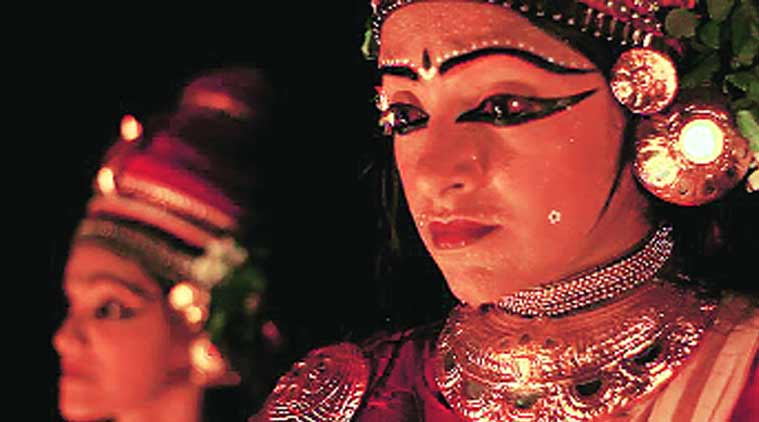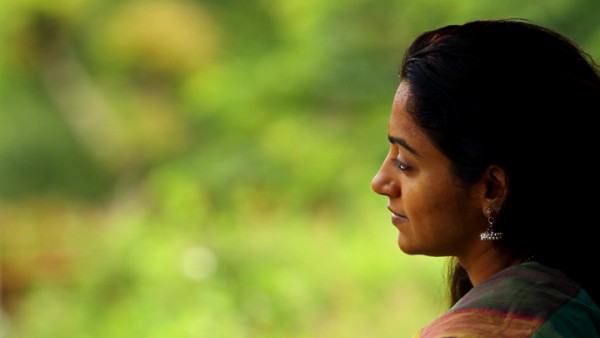Documentaries on Indian classical performing arts have been of two kinds. One, based on the history of the art form and the other, usually bio-sketches of artistes detailing their lives, journeys, awards and achievements. Kapila, directed by Sanju Surendran for the Films Division and a winner at the 62nd the National Award for Best Art/Cultural Film, falls in the grey area between these two. The film is not a bio-sketch about Koodiyattam performer Kapila Venu. It is not about the history of Koodiyattam either. So, what is it then? I would say it is a genuine effort in deconstructing one of the most complex art forms that has stood the ravage of time.
Until the 1980’s, almost no one outside of Kerala had a vague clue about what Koodiyattam was. It survived, silently, over time, in remote corners of Kerala. A few academic scholars of theatre were trying hard to propagate the form. It was under the chairmanship of playwright, film director and actor Girish Karnad that Koodiyattam came into thelimelight. Through his untiring efforts at the Central Sangeet Natak Akademi to provide grants to veteran Guru Mani Madhava Chakyar and other senior practitioners, the art form got a fresh lease of life. Karnad should easily be hailed as the revivalist godfather for this form in the twentieth century.
As the film opens, we see Kapila’s face practice eye exercises in the low light of a flickering oil lamp. A male voice gives her directions in the background, like it was some kind of a voiceover. The voice asks the eyes to look up at the sky. The eyes look up. The voice asks the eyes to look down into the nether worlds. The eyes follow. The voice tells the eyes to stretch and see the vast horizons of a seashore. The eyes follow. This goes on for a while making you restless to question what is going on. After all, what we can see are just a pair of eye balls swinging into every direction, taking instructions from this voice. What the voice does to the eyes of Kapila, it does to us as spectators. In a clever way it makes us understand how important it is to ‘ready yourself’ to engage with the art form, and the performer. To stretch your imagination and go beyond reason is one of the things the voice in the dark and these eyes are trying to tell you. To take grasp of a whole new world that thrives and exists parallel to yours; a world of uninhibited Rasa. This is the essence of Koodiyattam, one of India’s oldest Sanskrit drama forms, performed by the Nangiyaars and Chakiyars in temples stages or Koothambalams of Kerala. The scene fades into the sound of rain pouring over inviting lush green landscape of Kerala. The editing cleverly juxtaposes a torrential downpour and a single drop of water slowly tipping off a straw roof. The same sense of stillness that one finds in the art form is now captured. Does nature inspire art or is art a reflection of nature, you wonder.
We see a short sequence of a honeybee trying to drink nectar from a flower. As we observe the slow and steady growth of life in Kapila’s fingers as they enact a buzzing bee with the flower in full bloom, the magic unfolds. A seated Kapila, in what could be an old temple ruin, fades away in front of our eyes. At once we see the bee, the flower, and the bee drinking nectar from the flower, the whole scene of a little garden and much more. The scene draws us in till we actually begin to think all of this is happening in front of your eyes. It finally takes a ‘cut-to’ to another scene before we realize that all this was but a lovely illusion. It makes us think how much is possible with something as innocuous as movement, which we take for granted. A mere twitch of an eyebrow, a subtle side-glance, a few hand gestures and a whole scene is created out of thin air in front of us, almost like a Dastaangoi’s detailed description from Aamir Hamza’s fantasy fiction tales. It is sublime.
Through the whole film, we barely hear Kapila talk. She leaves her art to tellingly speak for her. There are no testimonials of famous people vouching for her or her art. Nor do we need them.
It is almost bizarre to see the two avatars of Kapila in the film. One is the homebound, charming housewife. Playing around with her photographer husband, talking to her parents, the erudite Nirmala Panicker and G Venu. Among other things, she is seen enjoying a popular video of Bharatanatyam legend Balasarswati, going through her archival photos of herself with her guru, the great Ammanur Madhava Chakyar, and sipping a cup of tea as life around her moves on. The other is Kapila performing on stage. She totally transforms into the character she is enacting. It makes you feel that possessed by her art, the Kapila on the stage barely recognizes the Kapila at home. This strange sense of stillness hovers around both these Kapilas. We see smart juxtapositions between these two entities on screen, making us wonder if all artistes, who are so involved with their art, manage such dual roles so effortlessly in real life. By the end, the documentary takes you on a complete journey through the complicated maze of Rasa. If one had to revisit the Advitic philosophy of Adi Shankara’s thought where he proclaims that the world is a reflection of one’s inner self, Kapila, as a film,successfully manages to capture this abstraction.
In 1998, UNESCO invited member states to nominate one form of cultural expression under a new category of International distinction they called “Masterpieces of Oral and Intangible Heritage of Humanity”. India selected Koodiyattam. The acclaimed parallel cinema director, Adoor Gopalakrishnan, agreed to to make a film on Koodiyattam but only if he could shoot in a traditional ‘Koothambalam’. Going by how conservative temple rules can be in South India, it was a daunting task. Strings were pulled to use the 16th century temple at Kitangur, the oldest of the surviving Koothambalams. A special high end camera was flown in from Mumbai. Round-the-clock shooting produced eleven hours of footage that was edited, subtitled, and submitted to UNESCO. The story goes that the adjudication committee, that met in Paris in 2001, needed to watch only fourteen minutes of the film before unanimously proclaiming Koodiyatam part of the world’s intangible cultural heritage. However as a film, the three-hour long documentary is surprisingly disengaging, often testing one’s patience as he or she views the film. There are no such issues with Kapila. With its poetic scenography, deft editing and some extremely evocative camera work by Manesh Madhavan, Kapila is easily one of the best documentaries made in the performing arts field.
Malayalam, Documentary, Color




Enjoyed reading about this documentary and shall look for it. Have known Kapila and her family for several decades, starting when I was her mother’s colleague at Lawrence School, Lovedale. Some years later I directed a documentary for Doordarshan on Koodiyattam for which I had the honour of interviewing Kapila’s guru, the late maestro, Ammanur Madhava Chakyar. I have also written an article for the U.S journal of the Arts, The World and I, titled “In the Footsteps of the Chakyars,” (in the late 1990s), featuring photography of a teenage Kapila, by an Italian photographer friend, Alexander Nitz. And now I see the talented artiste Kapila, who has come into her own. Full circle. Well done, Upper Stall!